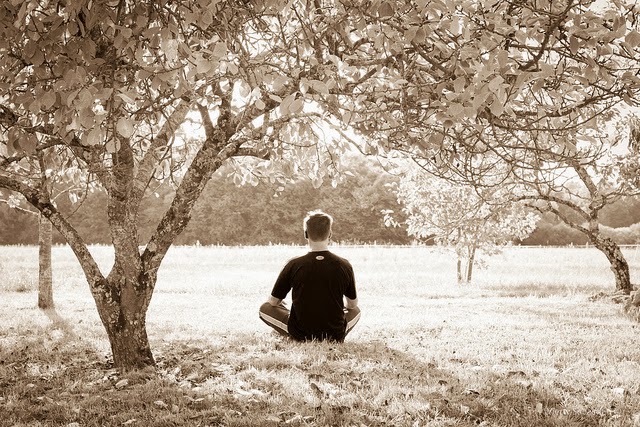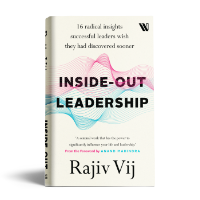
Photo by Wiertz Sebastien
“Meditation is the discovery that the point of life is always arrived at in the present moment.”
– Alan Watts, British-born philosopher
Hope you have had a great start to the New Year. Wish you and your loved ones a very Happy, Healthy and Meaningful year ahead!
This is that time of the year when we tend to reflect on the year gone by and make new personal resolutions for the year ahead. However, if there’s one idea I would love for you to consider this year, it would be to include a few minutes of daily meditation practice in your life.
Our modern lives are so stressful – driven by both, the innumerable opportunities and our insatiable ambition, we lead very fast-paced lives, juggling multiple balls. Unfortunately, despite the significant economic progress around us, as a society, we are not necessarily any happier. Notwithstanding individual successes, many of us experience incompleteness within.
Why meditate
If you can’t eliminate or even reduce stress in your life, maybe you should consider learning ways to better manage it. Meditation is a proven method to achieve exactly that. Besides helping you find greater calm, content and peace, meditation has numerous other benefits.
Significant quantum of research demonstrates that meditation practice can noticeably improve all aspects of an individual’s life – health, relationships, emotional well-being, work productivity and creativity. Independent studies at the National Institute of Health, and at Harvard, reported that regular meditation reduces chronic pain, anxiety, high blood pressure, cholesterol and cortisol, the stress hormone.
Meditation is also proven to increase serotonin production, which influences mood and behavior. Low levels of serotonin are normally associated with depression, obesity, insomnia and headaches. Meditation supports an individual’s growth of self-confidence, calmness, and tolerance. Peaceful thoughts, speech and actions, developed by meditating individuals, lead to greater harmony in their immediate relationships.
How to meditate
Many of my coaching clients are interested in exploring the idea of meditation, but either feel overwhelmed by the available choices or are intimidated by the intensity of some of the techniques. Besides, many of them don’t end up creating the time to do the research or start a practice.
In order to bridge that gap, here’s a mindfulness meditation technique that I would like to share. It is a twenty-minute practice, which I believe can be a solid starting point. It focuses particularly on three elements – cultivating gratefulness, practicing mindfulness, and developing loving-kindness.
To practice, find a place in your home where you won’t be disturbed for twenty minutes. Sit cross-legged on a cushion, preferably without any backrest. It’s ideal to sit upright, but comfortably – neither slouching, nor too stiff. Let your hands rest on your knees and keep your eyes closed.
The technique
Cultivating gratefulness:
Start with feeling grateful for some of the key things that are working, or have worked, well for you in life. This could include aspects from your relationships, career, health, friendships, lucky breaks, personality traits and so forth. Usually, we get so caught up with what appear as limitations in our life; creating a list of things you are grateful for in life, and reflecting on it, has a favorable influence on your level of calmness, confidence, and contentment.
Regularly reminding ourselves of the key highlights from this list keeps us attuned to the bigger picture of our existence and away from the relatively insignificant mental anxieties of daily life. As we pay greater attention to the beauty and miracles of our existence, the more they grow in our life.
Practicing mindfulness:
This is the core of the entire technique. Mindfulness means being aware of the present moment. For this, continue keeping your eyes closed and focus your attention on your breath. Generally, it is easy to notice and experience our breath either just below the nostrils or with the rise and fall of our stomach. Choose whatever works best for you.
The aim of this practice is to keep your attention concentrated on the breath for the following fifteen minutes. Invariably, you will quickly get distracted with, and caught up in, your thoughts. Every time you realize that, acknowledge it, and without judging yourself or the thought, bring your attention back to your breath. As we judge or engage with our thoughts, their hold on us grows. As we stay attuned to the breath, the thoughts slowly fade away.
Concentrating in this way stills the mind and sharpens its focus, facilitating a deeper clarity, higher level of awareness, and a unique state of restful alertness. Further, staying close with the rhythmic nature of the breathing process has a calming effect on the mind. Breath is always in the present, we are only breathing the current breath never the last or the next one. Thus, focusing our attention on the breath helps us be in the present, without getting caught up in the thoughts and drama of the past or the future.
Further, practicing this technique can, over time, significantly raise the level of our concentration in any given moment, resulting in greater focus and productivity in whatever we maybe engaged in.
Developing loving-kindness:
Lastly, we can spend a few minutes developing loving kindness and compassion towards ourselves as well as others. A number of Buddhist practices too lay a lot of importance to this aspect. A big part of our stress and unhappiness emanates from how we judge others and ourselves – this generates negative feelings of blame, guilt, and frustration in our psyche.
Developing loving-kindness towards ourselves supports us in loving and accepting ourselves as we are. As part of this practice, spend a few minutes mentally accepting love, kindness and compassion for yourself, accepting yourself as you are, and letting go of the burden of mistakes and regrets that you carry. Over time, you can include sending similar loving and compassionate thoughts to your partner, family, friends, and colleagues.
Other details:
You can spend about twenty minutes doing this practice, possibly split as 2-3 minutes of gratefulness, 15 minutes of mindfulness, and 2-3 minutes of loving-kindness. It would be ideal if you can carve out a fixed time of the day to practice this – being regular in your practice is crucial. For busy executives, setting aside a morning time, before they switch on their blackberries and start their day, usually works best. Twenty minutes spent on this will likely save you more than that during the rest of your day.
Frequent questions
For most meditators, and definitely when we are beginning, a number of questions crop up as we sit down to practice. Am I doing it right, is my breath too shallow or too fast, why can’t I focus even for a minute, how come I get distracted so quickly, does this kind of effort even matter, do most people struggle with meditation and so forth.
As Pema Chodron, the Buddhist teacher, said, “If it weren’t for my mind, my meditation would be excellent.”
It is crucial that you be mindful that committing to practicing on a daily basis is progress already. Also, every time you have a question, remember your goal is to pay attention to the breath; thus, rather than get embroiled in finding the most satisfactory answer, just remind yourself to ‘be here now’, focused on the breath and nowhere else. The rest will take care of itself
Finally
Committing to meditating regularly, irrespective of our circumstances, is a real test of patience. Make an upfront, non-negotiable time commitment for this, or any other meditation technique that you are familiar with, this New Year and you may well be pleasantly surprised with the changes you may experience in yourself and your work, relationships and life.
Would love to hear of your experiences with, or any questions on, meditation. Do leave a comment.











 Personal Mastery and World Consumption Levels
Personal Mastery and World Consumption Levels Passionate Detachment: The Sweet Spot of Life
Passionate Detachment: The Sweet Spot of Life Will The Rich Change For The Sake Of The Climate?
Will The Rich Change For The Sake Of The Climate? To Go From Expertise To Mastery: Learn To Let Go
To Go From Expertise To Mastery: Learn To Let Go
Thank you for the simple and wonderful article on Meditation. Last year I had a chance to attend the Vipassana course as taught by S.N. Goenkaji.
What you have outlined is simple and when practiced regularly gives results in terms of calming the mind and being kind to self and others.
To share with you I practice appx. 30 minutes of breathing meditation followed by observing the sensations in the body as part of insight meditation and finally loving kindness for 4-5 minutes.
At the end of the session sometimes I feel satisfied and on other days a little dissatisfied, but none the less I am working on myself to develop equanimity.
It is always wonderful to read your articles with lot of insight and I do try to implement to become abetter person each day.
Many thanks for sharing your thoughts Sudhir, appreciate it. Wonderful to hear of your commitment to practice Vipassana meditation on a regular basis. All the very best with our journey!
Is meditation best on an empty stomach? There are several ‘guided meditation’ tracks available, these days. Is an instructional (voice) track better, or purely a musical one preferable? Some recommend rigorous breathing in and out, while others advocate normal, even slow breathing. Finally, what would be the shortest possible time frame? Thanks and regards,
So much is written about meditation but i never got it. Rajiv describes it in such a simple, practical and doable way. A great contribution to all those who want to but did not know how to .. Thanks
Please consider coming out with a simple guided meditation audio or video file in your voice. It will be very helpful. Thanks.